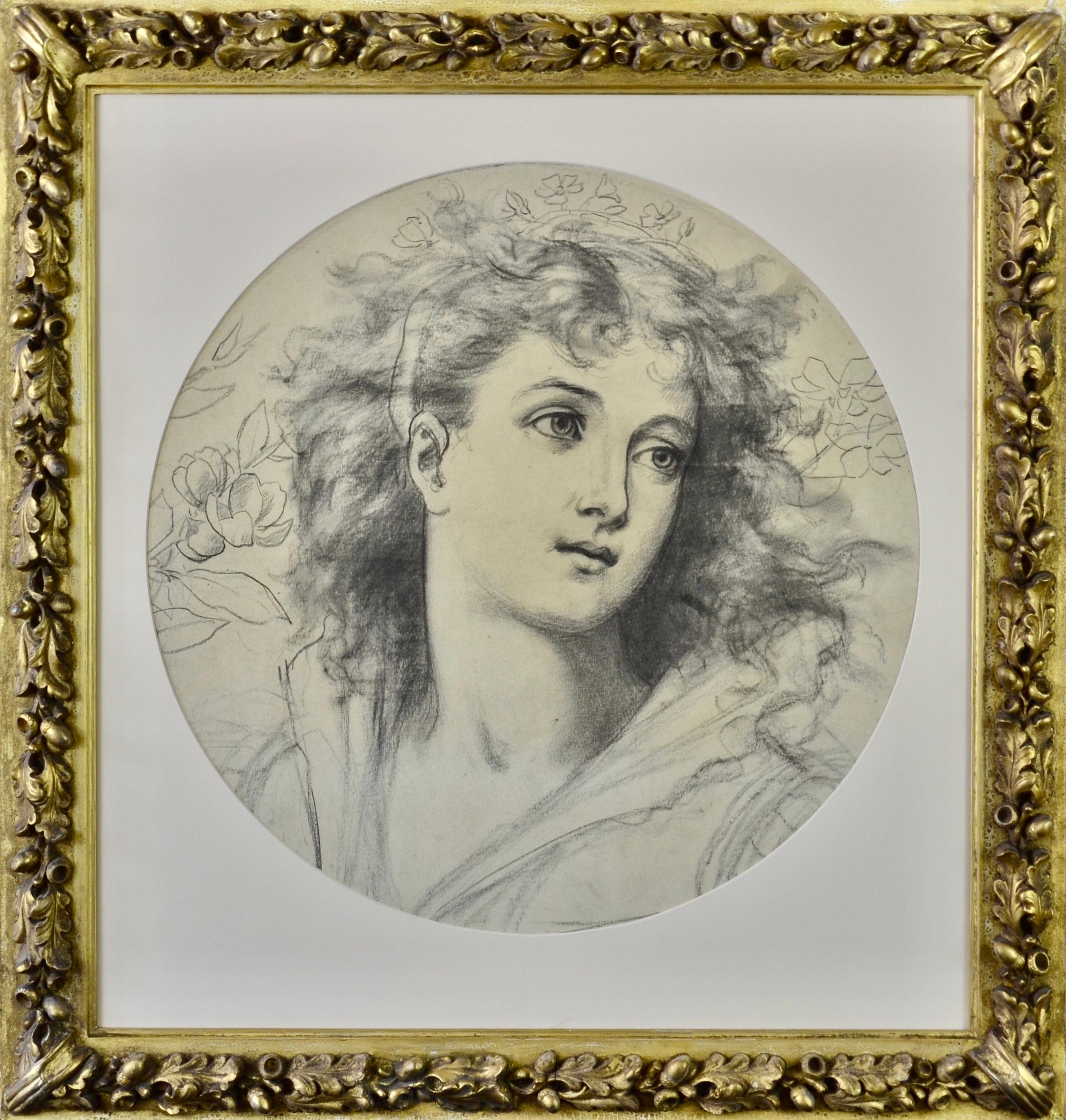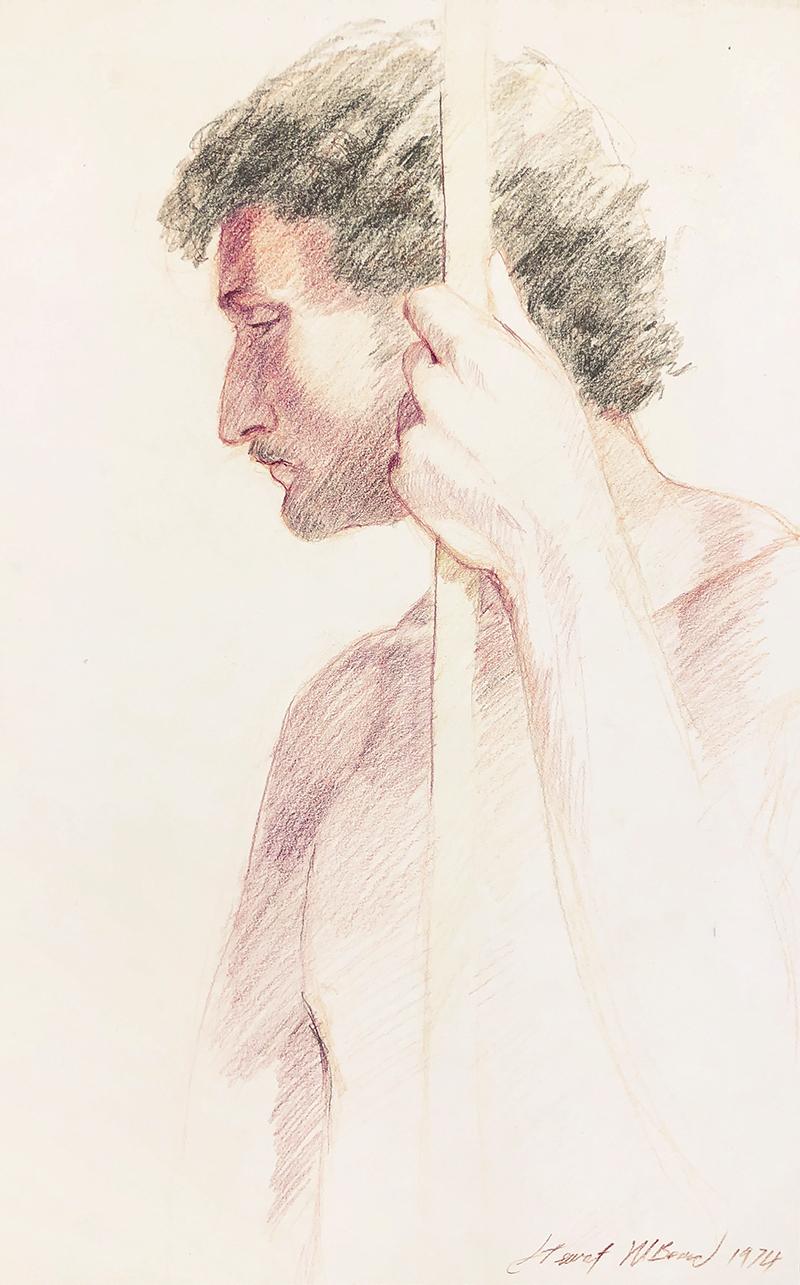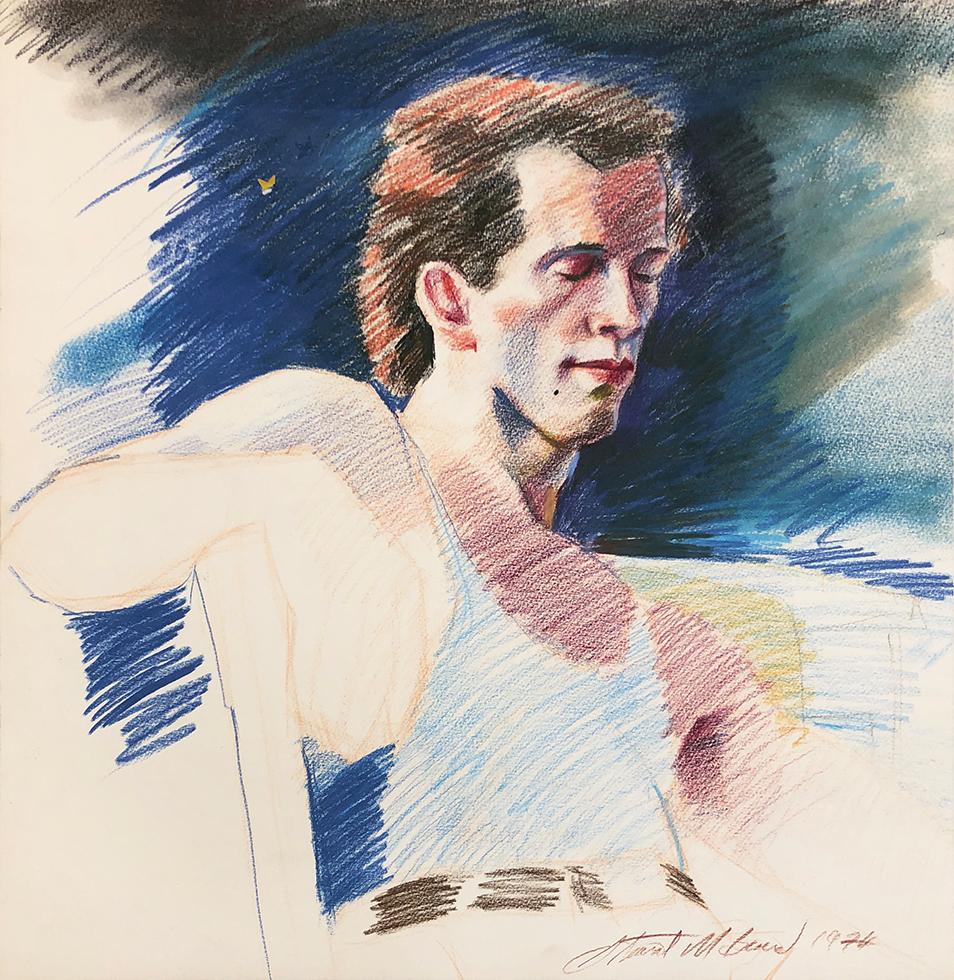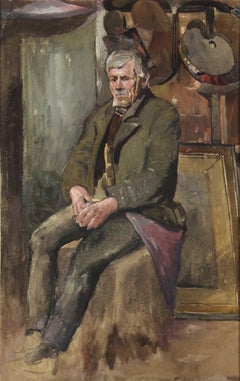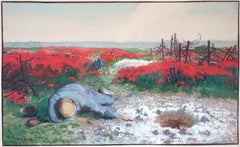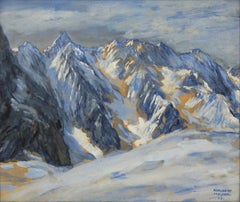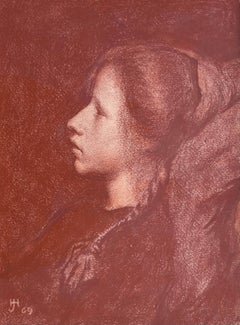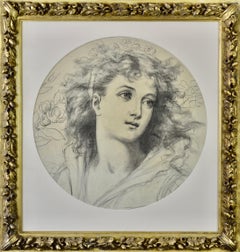Items Similar to Half-length portrait of a Pharisee - In the shadow of betrayal -
Want more images or videos?
Request additional images or videos from the seller
1 of 8
Hermann PrellHalf-length portrait of a Pharisee - In the shadow of betrayal -1885
1885
About the Item
Hermann Prell (1854 Leipzig - 1922 Dresden-Loschwitz). Half-length portrait of a Pharisee, 1885. Sketch for the right-hand figure in the painting Judas Iscariot, 1886. Pencil drawing heightened with opaque white and black chalk on beige-grey wove paper (papier vélin), 34 x 27.8 cm (visible size), 52 x 45 cm (mount), signed, dated and inscribed "H. PRELL 1885 zu 'Judas'".
Minor browning, collection stamp on the reverse.
- In the shadow of betrayal -
About the artwork
This painting is the sketch for the head of the Pharisee offering the coins to Judas in one of Herrmann Prell's major works, the painting Betrayal of Judas, completed in 1886. The painting belongs to the Staatliche Kunstsammlungen Dresden and is illustrated in Adolf Rosenberg: Prell, Bielefeld and Leipzig 1901, p. 21 (Fig. 19). It is especially highlighted in Thieme-Becker (vol. 27, p. 376).
Hermann Prell, Betrayal of Judas, 1886
The monumental head, which fills the picture and is distinguished by its ornamented robe, is almost a lost profile, which in the executed painting is justified by the Pharisee's turning towards Judas. Despite the fact that the sitter withdraws from the viewer by turning away, it was necessary to artistically elaborate the motivation for the purchase of one of Christ's disciples, which is why the drawing focuses on the expression of the face, while the 'accessories' are treated in a more summary manner.
In characterising the face, Hermann Prell performs a balancing act: since the Pharisee, despite his destructive actions, is an actor in the history of salvation, the head must show a dignity appropriate to the event, but at the same time the physiognomy must also bear witness to the scheming attitude that led to the betrayal. To solve this dilemma, Prell draws on the traditional depictions of the heads of the apostles, shading the face to indicate the obdurate darkness of the spirit and moving the base of the nose slightly upwards while the mouth falls away, thus giving a physiognomic expression to the motivation of the action. The fatal drama of the betrayal is expressed in the monumentalisation of the head and in the thunderous white highlights that contrast with the darkness of the chalk.
As a study, considered by the artist to be a work in itself, this drawing reveals the pictorial problems and brainstorming of monumental painting.
About the artist
In 1872 Prell, who was one of the most important exponents of monumental painting of his time, began studying painting with Theodor Grosse at the Dresden Academy of Art and continued with Carl Gussow at the Berlin Academy in 1876. Hans von Marées taught him in Rome in 1878. More influential on his work, however, were Arnold Böcklin and Max Klinger, with whom Prell had been friends since his student days and with whom he worked together on several occasions.
Prell's first major work, which established his reputation as a monumental painter, were the frescoes in the banqueting hall of the Architektenhaus in Berlin in 1881/82, commissioned by the state and depicting the different periods of architecture. Prell then went to Italy for two years to study fresco painting. Other major commissions followed. These included monumental frescoes in the town halls of Worms (1884), Hildesheim (1882-92), Gdansk (1895) and Dresden, the staircase of the Silesian Museum of Fine Arts in Breslau (1893/94), the throne room of the German Embassy in Rome (1896-99) and the staircase of the Albertinum in Dresden (1900-1904).
From 1886 Prell taught at the academy of arts in Berlin and in 1892 he was appointed professor at the academy of arts in Dresden. His students included Osmar Schindler and Hans Unger. During his time in Dresden Prell belonged to the group around Carl Bantzer, who later formed the Goppeln artists' colony.
An extensive collection of Hermann Prell's works is kept at the Städtische Galerie Dresden. Otto Schiller and Martin Schauss made busts of Hermann Prell and Walter Witting a medal of honour. In the Roemer Museum in Hildesheim a whole room was once dedicated to Hermann Prell. Many of Prell's important works were lost in 1945.
Selection of public collections that own works by Hermann Prell:
Albertinum Dresden, Städtische Kunstsammlung Chemnitz, Stadtmuseum Bautzen.
Selected bibliography
Adolf Rosenberg: Prell. Mit 115 Abbildungen nach Gemälden, Zeichnungen und Skulpturen, Bielefeld 1901.
George Galland: Hermann Prell. Fresken, Skulpturen und Tafelbilder des Meisters, Leipzig 1916.
Hartwig Fischer: Ein Wilhelminisches Gesamtkunstwerk auf dem Kapitol. Hermann Prell und die Einrichtung des Thronsaals in der Deutschen Botschaft zu Rom 1894–1899. Hamburg 1998.
Christel Wünsch: Hermann Prell. In: Die Kunst hat nie ein Mensch allein besessen. Dreihundert Jahre Akademie der Künste und Hochschule der Künste Berlin. Katalog Akademie der Künste und Hochschule der Künste, Berlin 1996, S. 317–319.
Heike Biedermann, Katrin Bielmeier: "Aber befreit empor zum Äther kreisen die Musen". Zur Ausgestaltung des Treppenhauses im Albertinum durch Hermann Prell. In: Dresdener Kunstblätter 54,4 (2010), S. 228-232.
GERMAN VERSION
Hermann Prell (1854 Leipzig - 1922 Dresden-Loschwitz). Brustbild eines Pharisäers, 1885. Studie zur rechten Figur zum Gemälde "Judas Ischarioth" von 1886. Mit Deckweiß gehöhte Zeichnung in Bleistift und schwarzer Kreide auf beigegrauem Velin, 34 x 27,8 cm, 52 x 45 cm (Passepartout), signiert, datiert und bezeichnet "H. PRELL 1885 zu 'Judas'".
Minimal gebräunt, Ränder mit Klebestreifen hinterlegt, rückseitig Sammlungsstempel.
Exposé als PDF
- Im Schatten des Verrats -
zum Werk
Das Bild ist der Entwurf für den Kopf desjenigen Pharisäers, der Judas auf einem der Hauptwerke Herrmann Prells, dem 1886 vollendeten Gemälde "Verrat des Judas", Judas die Münzen darbietet. Das Gemälde gehört den Staatliche Kunstsammlungen Dresden und ist abgebildet in: Adolf Rosenberg: Prell, Bielefeld und Leipzig 1901, S. 21 (Abb. 19). Im Thieme-Becker wird es eigens hervorgehoben (Bd. 27, S. 376).
Hermann Prell, Der Verrat des Judas, 1886
Der bildfüllende durch das ornamentierte Prunkgewand ausgezeichnete, monumental wirkende Kopf ist beinahe ins verlorene Profil gewendet, was auf dem ausgeführten Gemälde durch die Hinwendung des Pharisäers zu Judas begründet ist. Trotzdem sich der Dargestellte dem Betrachter durch seine Abwendung entzieht, galt es, die Motivation des Kaufs einer der Jünger Christi künstlerisch herauszuarbeiten, weshalb die Zeichnung auf die Ausprägung des Gesichtsausdrucks fokussiert ist, während das 'Beiwerk' eine eher summarische Behandlung erfährt. Bei der Charakterisierung des Gesichts meistert Hermann Prell eine Gradwanderung: Indem der Pharisäer trotz seines zerstörerischen Handelns ein Akteur der Heilsgeschichte ist, hat der Kopf eine diesem Geschehen entsprechende Würde aufzuweisen, zugleich muss die Physiognomie aber auch von der intriganten, den Verrat in die Wege leitenden Einstellung zeugen. Zur Lösung dieses Dilemmas bezieht sich Prell auf traditionelle Darstellungen von Apostelköpfen, verschattet das Gesicht, um die verstockte Dunkelheit des Geistes anzuzeigen und rückt den Nasenansatz leicht hoch, während die Mundpartie abfällt, wodurch der Motivation des Handelns ein physiognomischer Ausdruck gegeben wird. Die am Verrat hängende fatale Dramatik kommt in der Monumentalisierung des Kopfes ebenso zum Ausdruck wie in den gewitterartig aufleuchtenden Weißhöhungen, die mit dem Dunkel der Kreide kontrastieren. In Form einer vom Künstler selbst als eigenständiges Werk angesehen Studie werden anhand dieser Zeichnung die Bildprobleme und die Ideenfindung der Monumentalmalerei sichtbar.
zum Künstler
1872 nahm Prell, der zu den wichtigsten Vertretern der Monumentalmalerei seiner Zeit zählt, das Studium der Malerei an der Dresdner Kunstakademie bei Theodor Grosse auf und setzte es 1876 bei Carl Gussow an die Berliner Akademie fort. 1878 unterrichtete ihn Hans von Marées in Rom. Prägender für sein Oeuvre wurden allerdings Arnold Böcklin und Max Klinger, mit welchem Prell seit Studienzeiten befreundet war und mehrfach zusammenarbeitete.
Prells erste größere Arbeit, die seinen Ruf als Monumentalmaler begründete, sind die in Staatsauftrag 1881/82 geschaffenen Fresken des Festsaales im Berliner Architektenhaus, auf denen die Epochen der Baukunst dargestellt sind. Im Anschluss daran ging Prell zwei Jahre nach Italien, um intensiv die Freskomalerei zu studieren. Es folgen weitere Großaufträge. Darunter Monumentalfresken in den Rathäusern von Worms (1884), Hildesheim (1882-92), Danzig (1895) und Dresden, die Ausmalung des Treppenhauses des Schlesischen Museums der bildenden Künste in Breslau (1893/94), des Thronsaales der Deutschen Botschaft in Rom (1896-99) und des Treppenhauses des Albertinums in Dresden (1900-1904).
Seit 1886 lehrte Prell an der Berliner Kunstakademie, 1892 erfolgte die Berufung zum Professor an die Dresdner Kunstakademie, um dort das Meisteratelier für Geschichtsmalerei zu leiten. Unter seinen Schülern waren Osmar Schindler und Hans Unger. In seiner Dresdner Zeit gehörte Prell zur Gruppe um Carl Bantzer, aus der sich später die Künstlerkolonie Goppeln formierte.
Ein umfangreiches Konvolut aus dem Nachlass von Hermann Prell wird in der Städtischen Galerie Dresden aufbewahrt. Otto Schiller und Martin Schauss haben Büsten und Walter Witting eine Ehrenmedaille Hermanns Prells angefertigt. Im Roemer-Museum Hildesheim war Hermann Prell ehemals ein ganzer Saal gewidmet. 1945 gingen eine Vielzahl bedeutender Werke Prells verloren.
"Ausgehend von Studien setzte Prell auf einen auf den Formen der Hochrenaissance basierenden Idealstil, der aber auf naturalistisch-illusionistische Wirkung zielte. In der Gesamtkomposition seiner Zyklen war Prell bestrebt, die Wand im Sinne des Barock zu ignorieren und durch fiktive Durchbrechungen derselben dem Besucher das Gefühl der Raumerweiterung zu geben."
Hans Vollmer im Thieme-Becker
Auswahl öffentlicher Sammlungen, die Werke von Hermann Prell besitzen:
Albertinum Dresden, Städtische Kunstsammlung Chemnitz, Stadtmuseum Bautzen.
Auswahlbibliographie
Adolf Rosenberg: Prell. Mit 115 Abbildungen nach Gemälden, Zeichnungen und Skulpturen, Bielefeld 1901.
George Galland: Hermann Prell. Fresken, Skulpturen und Tafelbilder des Meisters, Leipzig 1916.
Hartwig Fischer: Ein Wilhelminisches Gesamtkunstwerk auf dem Kapitol. Hermann Prell und die Einrichtung des Thronsaals in der Deutschen Botschaft zu Rom 1894–1899. Hamburg 1998.
Christel Wünsch: Hermann Prell. In: Die Kunst hat nie ein Mensch allein besessen. Dreihundert Jahre Akademie der Künste und Hochschule der Künste Berlin. Katalog Akademie der Künste und Hochschule der Künste, Berlin 1996, S. 317–319.
Heike Biedermann, Katrin Bielmeier: "Aber befreit empor zum Äther kreisen die Musen". Zur Ausgestaltung des Treppenhauses im Albertinum durch Hermann Prell. In: Dresdener Kunstblätter 54,4 (2010), S. 228-232.

About the Seller
5.0
Gold Seller
These expertly vetted sellers are highly rated and consistently exceed customer expectations.
Established in 2014
1stDibs seller since 2023
10 sales on 1stDibs
- ShippingRetrieving quote...Ships From: Berlin, Germany
- Return PolicyA return for this item may be initiated within 14 days of delivery.
Authenticity Guarantee
In the unlikely event there’s an issue with an item’s authenticity, contact us within 1 year for a full refund. DetailsMoney-Back Guarantee
If your item is not as described, is damaged in transit, or does not arrive, contact us within 7 days for a full refund. Details24-Hour Cancellation
You have a 24-hour grace period in which to reconsider your purchase, with no questions asked.Vetted Professional Sellers
Our world-class sellers must adhere to strict standards for service and quality, maintaining the integrity of our listings.Price-Match Guarantee
If you find that a seller listed the same item for a lower price elsewhere, we’ll match it.Trusted Global Delivery
Our best-in-class carrier network provides specialized shipping options worldwide, including custom delivery.More From This Seller
View AllSketch of a head - Carved in stone -
Located in Berlin, DE
Emil Faesch (1865 Basel - 1915 Basel). Sketch of a head. Charcoal on painting cardboard, 60 x 47.5 cm (folio size), signed and dated at lower right "E. Faesch. 1888.".
Minor browning.
- Carved in stone -
About the artwork
The life-size head has an immensely present presence. This effect is due to the fact that Faesch took his cue from academic classical...
Category
1880s Realist Figurative Drawings and Watercolors
Materials
Chalk
Man sitting in the studio - Thinking about art -
Located in Berlin, DE
Adolph Eduard Otto von Faber du Faur (1828 Ludwigsburg - 1901 Munich). Man sitting in the studio. Watercolour painting, 43 x 27 cm (visible size), 73 x 53 cm (frame), monogrammed at lower right, estate stamp.
Upper right corner neatly repaired, small tear in the wall to the left of the sitter.
- Thinking about art -
About the artwork
The sitter, an elderly man, is seated in a studio on a pedestal reminiscent of an academy hall. The earthy, dark tones give the scene a weighty quality. The lightest tones are found in the incarnate parts of the figure, which do not stand out from the other colours of the picture, but are linked to them. As a result, the sitter's face is both part of and the highlight of the colour references in the picture. The colour of the sitter's skin is reflected in his pink coat, while his white-grey hair matches the colour of the wall next to him. This almost monochrome wall surface, in turn, is connected across the portrait to the framed picture standing on the floor, which seems to have been erased by this correspondence with the empty wall surface. Through the palette, which is positioned directly behind the sitter's head, the reference to painting, which is already given by the studio space, is explicitly linked to the sitter, who thus seems to be contemplating the question of the meaning of art.
This raises the question of whether Faber Du Faur, who had become lonely in his old age, might have painted a self-portrait here in his later years. In addition to the studio setting, the sitter's explicit reference to the palette and the fact that the picture was part of his estate, the only summary elaboration of the body suggests a self-portrait, while the representation of the face is concretised with the wide-open eyes typical of a self-portrait. This concentration on the face gives the impression of the artist's melancholy introspection, captured by the palette and related to the meaning of painting, whose dark character is reinforced by the concealment of the palette hanging on the right of the picture in the light tones so characteristic of Faber Du Faur. In the course of this resignation, Faber du Faur advises his son Hans, who has also become a painter: "Promise me one thing: never move to Munich, they'll kill you here!"
Whoever the sitter may be, the references to painting make the portrait a resigned self-contemplation by Faber Du Faur, focused on art.
About the artist
After leaving school, Otto Faber du Faur entered the service of the Württemberg army, at the same time cultivating his artistic talent. In 1851, on the recommendation of his father Christian Wilhelm, who was himself a battle painter, he spent six months in Munich as an apprentice to Alexander von Kotzebue. In 1852 he was granted a year's leave of absence from military service to study battle painting in the studio of Adolphe Yvon...
Category
1890s Realist Portrait Drawings and Watercolors
Materials
Watercolor
Red blooming war landscape with dead soldier - Bleeding flowers -
Located in Berlin, DE
Johannes Friedrich Heinrich Hänsch (1875-1945), Red blooming war landscape with dead soldier, 1918. Watercolor and gouache on paper, 15 x 24.5 cm (image), 27 x 37 cm (sheet size / frame), monogrammed and dated "19JH18" at lower left.
- Paper slightly darkened
About the artwork
Despite the relatively small format, the watercolor with an internal frame depicts a panoramic view of a flat landscape stretching to the horizon. As far as the eye can see, the poppies bloom in flaming red. The flowers are not rendered individually, however, creating an almost cohesive red surface. The bright red is interspersed with vegetal green. A complementary contrast that creates an intense color effect. In this color contrast, a white area breaks through from the middle ground, widening towards the foreground and surrounding a brown hole. Next to it, in blue, is the actual protagonist of the painting, the first thing that catches the eye: a dead soldier. Next to him is his helmet, revealing the empty interior. The brown, hollow shape corresponds to the hole in the ground. A shell funnel is surrounded by bright ash, which, like the inverted helmet, becomes a sign of death. The soldier's arms point to the funnel, while the empty helmet paraphrases the calotte of the skull and, like the funnel, thematizes the empty darkness of death.
The soldier's body, however, is intact and not - as in Otto Dix's triptych "The War" - a dismembered corpse. Instead, Johannes Hänsch activates the landscape, especially the color, to illustrate a blooming landscape of death that extends from the shell funnel in the foreground to the rising column of smoke on the horizon. If the soldier's body is intact, the tangle of barbed wire emblematically placed over the empty helmet also appears tattered. On the right side of the picture, the barbed wire even seems to stretch its arms to the sky in horror. Against the background of this allegory, the content of the bright red also becomes clear: the landscape is drenched in blood, literally a sea of blood, and the single unknown soldier stands pars pro toto for all those who died on the battlefield. Dying in war is not dying in community, but in solitude. In order to emphasize the isolation in death, Johannes Hänsch has set the blue of the soldier in the axis given by his body in the middle ground of the picture into the red sea.
A master of landscape painting, Hänsch succeeds in creating a natural-looking landscape allegory that illustrates the horror and death of war, without depicting the brutality of war itself. This singular 'war memorial' of the unknown soldier is the opposite of heroization and yet the dignity of the deceased soldier is preserved through the integrity of his body.
About the artist
As the son of the sculptor Adolf Haensch, the young Johannes received his first artistic training in his father's Berlin studio. However, he eventually decided to become a painter, and in 1897 he entered the Berlin Academy of Arts. He initially studied under Paul Vorgang and Eugen Bracht, and was particularly influenced by Bracht's increasingly colourful landscape painting. In 1901 he moved to the class of Friedrich Kallmorgen, with whom he spent several weeks on excursions into nature. In 1905 he became a master pupil of Albert Hertel, who taught him watercolour painting.
From 1903 to 1933 he exhibited annually at the Great Berlin Art Exhibition, the exhibitions of the Berlin Artists' Association and the Munich Glaspalast. In 1905 he was awarded the Carl Blechen...
Category
1910s Realist Figurative Drawings and Watercolors
Materials
Watercolor
Wettersteinkamm - The blue of the mountains -
Located in Berlin, DE
Adalbert Holzer (1881 Munich - 1966 Munich). Wettersteinkamm. Watercolour, 29 x 34.5 cm (visible size), 37.5 x 43 cm (frame), signed and dated at lower right 'ADALBERT HOLZER [19]23'.
Framed behind glass. Frame shows signs of wear.
- The blue of the mountains -
About the artwork
The Wetterstein ridge is revealed to the viewer from a gentle, snow-covered hill. In contrast to conventional depictions of mountains, the painting is composed entirely of shades of blue, which condense into the blue-grey of the rock or fade into the white of the snow. As a complementary colour to the blue, Holzer virtuously activates the ochre ground. The uniform yet exciting polarity of the colours emphasises the massive majesty of the mountains and at the same time underlines the special character of the Wetterstein ridge. Holzer transferred the translucency of glass painting, in which he was originally trained, to watercolour and developed a pictorial language related to the art of Ferdinand Hodler, which earned him the nickname 'Master of Blue' and led to the appreciation of his watercolours in particular.
About the artist
After an apprenticeship as a stained glass painter at the Kunstgewerbeschule, Adalbert Holzer studied at the Munich Art Academy under Carl von Marr...
Category
1920s Realist Landscape Drawings and Watercolors
Materials
Watercolor
Self-portrait - Homo nudus -
Located in Berlin, DE
Bruno Paul (1874 Seifhennersdorf - 1968 Berlin). Self-portrait, c. 1895. Pencil on paper, mounted on cardboard, 53.5 x 35 cm, signed 'Paul' at upper left.
- Homo nudus -
About the artwork
In a mirrored situation, Bruno Paul looks at himself in the picture. While his body, which is the size of the format, is shown in profile parallel to the picture, he turns his head into the picture in order to become aware of himself there, whereby the lighter use...
Category
1890s Realist Figurative Drawings and Watercolors
Materials
Pencil
Study with Torso, Hands, and Umbrella - The characteristic of the inconspicuous
Located in Berlin, DE
Paul Friedrich Meyerheim (1842 Berlin - 1915 ibid.). Sketch of a female torso with hands and an umbrella. Pencil on paper, 27.5 x 22.5 cm (visible size)...
Category
1890s Realist Figurative Drawings and Watercolors
Materials
Pencil
You May Also Like
Reverie - Early 20th Century British chalk drawing of a girl by H J Harvey
By Herbert Johnson Harvey
Located in London, GB
HERBERT JOHNSON HARVEY
(British 1883-1956)
Reverie
Signed with monogram and dated l.l.: HJ 09
Red chalks
Framed
29.5 by 22 cm., 11 ¾ by 8 ¾ in.
(fra...
Category
Early 20th Century Realist Portrait Drawings and Watercolors
Materials
Chalk
Spring - Chalk design drawing for a Minton plaque by Herbert Wilson Foster
By Herbert Wilson Foster
Located in London, GB
HERBERT WILSON FOSTER
(1846-1929)
Spring
Inscribed with title beneath the mount
Chalk, circular
Framed
Diameter 42 cm., 16 ½ in.
(frame size 61 by 58 cm., 24 by 22 ¾ in.)
Herbert Wilson Foster was born in Endon, Staffordshire. He attended Hanley School of Art before continuing his studies in London, Belgium and France. His paintings of rural and domestic subjects were exhibited at the Royal Academy between 1873 and 1899. In 1893 he accepted a teaching position at the Nottingham School of Art, where his pupils included Laura Knight and Harold Knight. Works by him are in the collections of the Minton archives; the Wisbech & Fenland Museum; Leicester Art Gallery; Rushcliffe Council and Nottingham Castle Museum.
In addition to his work as a painter he worked as a porcelain painter, working at one point on the tile panels in the Victoria & Albert Museum. He is known to have worked at Mintons from 1872 where he specialized in portraits of contemporary personalities, including members of the Royal Family. This head of a girl was probably intended for a painted ceramic wall charger...
Category
1870s Realist Figurative Drawings and Watercolors
Materials
Pencil, Chalk
Summer - Chalk Drawing Design for Minton charger by Herbert Wilson Foster
By Herbert Wilson Foster
Located in London, GB
HERBERT WILSON FOSTER
(1846-1929)
Summer
Inscribed with title beneath the mount
Chalk, circular
Framed
Diameter 42 cm., 16 ½ in.
(frame size 61 by 58 cm., 24 by 22 ¾ in.)
Herbert Wilson Foster was born in Endon, Staffordshire. He attended Hanley School of Art before continuing his studies in London, Belgium and France. His paintings of rural and domestic subjects were exhibited at the Royal Academy between 1873 and 1899. In 1893 he accepted a teaching position at the Nottingham School of Art, where his pupils included Laura Knight and Harold Knight. Works by him are in the collections of the Minton archives; the Wisbech & Fenland Museum; Leicester Art Gallery; Rushcliffe Council and Nottingham Castle Museum.
In addition to his work as a painter he worked as a porcelain painter, working at one point on the tile panels in the Victoria & Albert Museum. He is known to have worked at Mintons from 1872 where he specialized in portraits of contemporary personalities, including members of the Royal Family. This head of a girl was probably intended for a painted ceramic wall charger...
Category
1870s Realist Figurative Drawings and Watercolors
Materials
Pencil, Chalk
Untitled (Man in Repose Leaning Against Post)
By Mark Beard
Located in New York, NY
Conté crayon on paper
Signed and dated, l.r.
This artwork is offered by ClampArt, located in New York City.
Mark Beard, born in 1956 in Salt Lake City, now lives in New York City. ...
Category
1970s Realist Figurative Drawings and Watercolors
Materials
Conté, Paper
Untitled (Man in Blue Tank Top)
By Mark Beard
Located in New York, NY
Pastel and conté crayon with partial foil star on Rives BFK paper
Signed and dated, l.r.
This artwork is offered by ClampArt, located in New York City.
Mark Beard, born in 1956 in ...
Category
1970s Realist Portrait Drawings and Watercolors
Materials
Foil
Untitled (Man Reading Newspaper)
By Mark Beard
Located in New York, NY
Conté crayon on paper
Signed, l.r.
This artwork is offered by ClampArt, located in New York City.
Mark Beard, born in 1956 in Salt Lake City, now lives in New York City. His works ...
Category
1970s Realist Figurative Drawings and Watercolors
Materials
Conté, Paper


